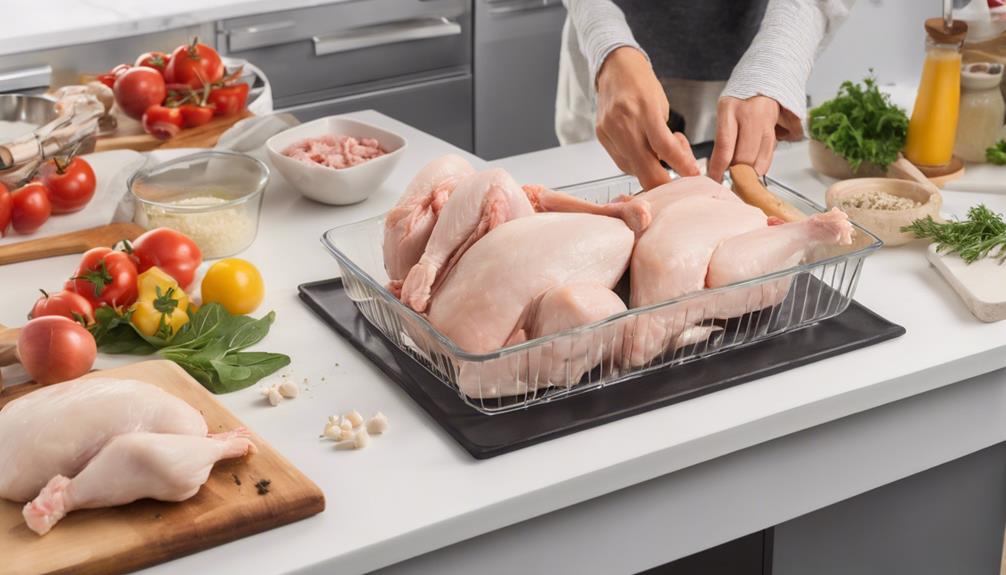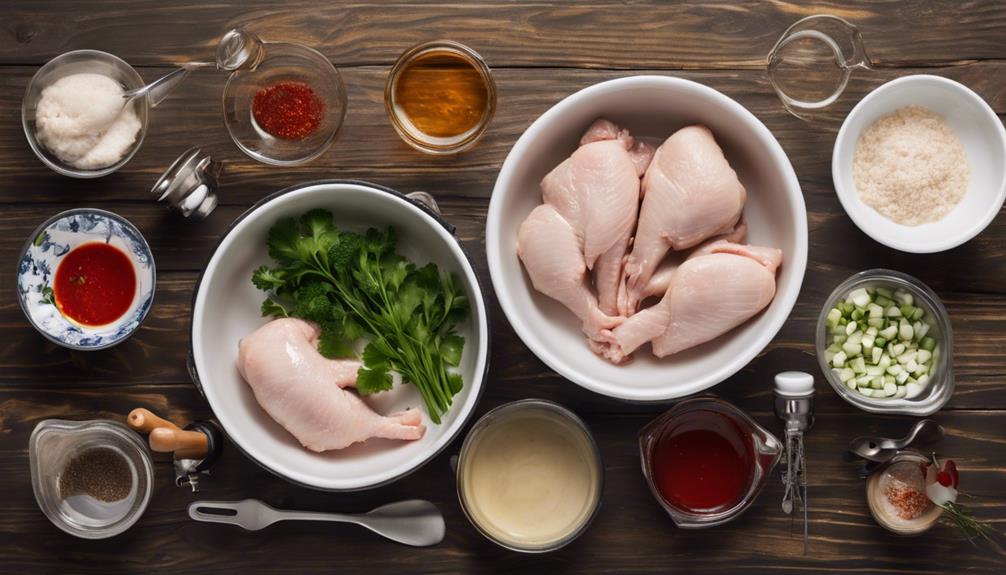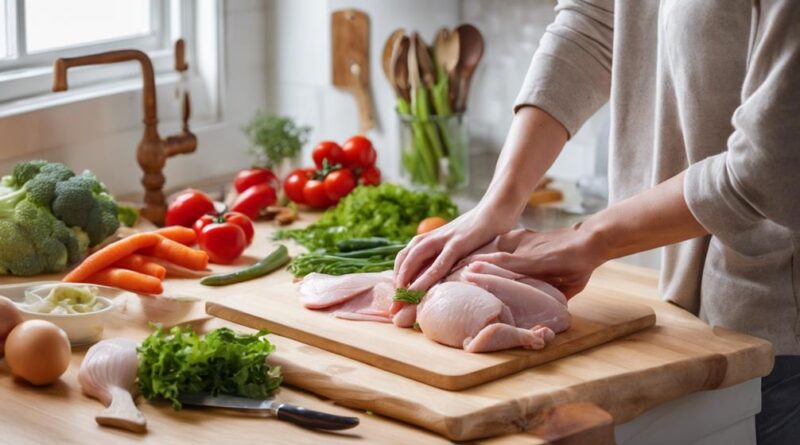10 Tips to Prevent Chicken Cross-Contamination"
To prevent chicken cross-contamination, store raw chicken in the coldest part of your fridge and separate it from other foods. Use designated cutting boards for chicken, wash them with hot, soapy water, and sanitize with bleach. Cook chicken to 165°F, brine safely, and use separate utensils for raw chicken. Sanitize your kitchen surfaces with bleach or hot, soapy water. Keep raw chicken on the bottom fridge shelf, use different plates for raw and cooked chicken, and clean hands thoroughly after handling. These tips are key to keeping your kitchen safe from harmful bacteria.
Proper Storage Practices
Are you storing your chicken correctly to prevent cross-contamination? Proper storage practices are crucial in maintaining food safety and preventing the spread of harmful bacteria. One key aspect to consider is temperature control. Raw chicken should always be stored in the coldest part of your refrigerator, which is typically the bottom shelf. Ensure that the temperature inside the fridge is set to 40°F (4°C) or below to inhibit the growth of bacteria.
When storing chicken, it's essential to use air-tight containers to prevent any juices from leaking and contaminating other foods. Opt for sealed plastic bags or containers specifically designed for storing raw meat. This not only prevents cross-contamination but also helps retain the freshness of the chicken.
Remember to store chicken on a plate or tray to catch any drips or leaks that may occur. This extra precaution will further reduce the risk of spreading bacteria to other surfaces in your refrigerator. Additionally, never leave raw chicken out at room temperature for an extended period; always promptly return it to the refrigerator after use.
Separate Cutting Boards
To maintain proper food safety and prevent cross-contamination, ensure you use separate cutting boards for raw chicken. Cross contamination risks are significantly reduced when you designate specific cutting boards for handling raw chicken. When you use the same cutting board for other foods like vegetables or cooked meats without proper cleaning in between, bacteria from the raw chicken can transfer onto these foods, increasing the risk of foodborne illnesses. By having dedicated cutting boards for raw chicken, you can effectively minimize this risk and uphold good food safety precautions.
It is crucial to choose cutting boards made of non-porous materials such as plastic or glass for handling raw chicken. These materials are easier to clean and disinfect thoroughly after each use. Remember to wash the cutting board with hot, soapy water immediately after cutting raw chicken. You can also sanitize the cutting board by using a solution of 1 tablespoon of unscented bleach per gallon of water. Ensure the cutting board is completely dry before using it again.
Handwashing Techniques
Using proper handwashing techniques is essential in preventing the spread of harmful bacteria and maintaining good hygiene practices in food preparation. When washing your hands after handling raw chicken, it's crucial to follow a thorough process to ensure all bacteria are removed effectively.
Start by wetting your hands with clean, running water. Apply enough soap to cover all hand surfaces. Rub your hands together to lather the soap, ensuring you reach all areas including the backs of your hands, between your fingers, and under your nails. Scrub your hands for at least 20 seconds. Remember to clean your wrists and forearms as well, as they can also come in contact with the chicken.
After scrubbing, rinse your hands thoroughly under clean, running water. Make sure all soap is washed away as residual soap can attract bacteria. Now comes the crucial step of proper drying. Use a clean towel to dry your hands thoroughly. Moist hands can harbor bacteria, so it's important to ensure they're completely dry.
In situations where soap and water aren't readily available, hand sanitizing techniques can be used. Choose a hand sanitizer with at least 60% alcohol content. Apply a palmful of sanitizer and rub it all over your hands until they're dry. Remember, hand sanitizers aren't as effective as handwashing with soap and water, so use them only when necessary.
Cook Chicken Thoroughly
Ensure that chicken is cooked thoroughly to kill any harmful bacteria and prevent foodborne illnesses. The cooking temperature for chicken should reach a minimum internal temperature of 165°F (73.9°C) to ensure it's safe to eat. To measure the temperature accurately, use a food thermometer inserted into the thickest part of the chicken, avoiding contact with bones.
Brining methods can also enhance the flavor and juiciness of the chicken while ensuring it remains safe to consume. Brining involves soaking the chicken in a mixture of water, salt, and sometimes sugar before cooking. This process helps the chicken retain moisture during cooking, resulting in a more tender and flavorful dish. If you choose to brine your chicken, ensure it's done safely by keeping it refrigerated during the brining process to prevent bacteria growth.
When cooking chicken, avoid undercooking as it can leave harmful bacteria alive, leading to potential foodborne illnesses. Conversely, overcooking can result in dry and tough chicken. By following recommended cooking temperatures and using brining methods appropriately, you can enjoy delicious, juicy chicken dishes while ensuring food safety for you and your family. Remember, proper cooking techniques are crucial in preventing cross-contamination and promoting good health.
Avoid Cross-Contaminated Utensils
When handling raw chicken, always keep separate utensils for cutting and preparing other ingredients to prevent cross-contamination. Utensil organization is crucial in minimizing cross-contamination risks in the kitchen. Designate specific cutting boards, knives, and other utensils solely for use with raw chicken. This separation helps prevent harmful bacteria present in raw chicken from coming into contact with ready-to-eat foods.
To maintain proper utensil organization, consider using color-coded cutting boards or clearly labeled utensils. This visual distinction serves as a helpful reminder to use specific utensils for handling raw chicken only. Additionally, store raw chicken utensils away from other kitchen tools to avoid accidental mix-ups.
When washing utensils used for raw chicken, thoroughly clean them with hot, soapy water. Avoid using the same sponge or dishcloth for cleaning utensils that were used with raw chicken to prevent cross-contamination. Consider using a dishwasher if possible, as it can help sanitize utensils more effectively.
Regularly inspect utensils for any signs of wear or damage. Cracks or scratches in cutting boards and utensils can harbor bacteria, increasing the risk of cross-contamination. Replace any damaged utensils promptly to maintain a safe cooking environment. By following these utensil organization practices, you can significantly reduce the chances of cross-contamination when handling raw chicken.
Sanitize Kitchen Surfaces
To maintain a hygienic kitchen environment, start by thoroughly sanitizing all kitchen surfaces regularly. Kitchen disinfection and surface sterilization are crucial steps in preventing cross-contamination from raw chicken to other foods.
Here are three essential tips to ensure your kitchen surfaces are properly sanitized:
- Use a Bleach Solution: Create a sanitizing solution by mixing one tablespoon of bleach with one gallon of water. Wipe down all surfaces that have come into contact with raw chicken, such as countertops, cutting boards, and sinks. Let the solution sit for a few minutes before rinsing thoroughly with water.
- Utilize Hot, Soapy Water: For surfaces that can't tolerate bleach, such as wooden cutting boards, use hot, soapy water for thorough cleaning. Scrub the surfaces well to remove any traces of raw chicken residue. Rinse with hot water and allow them to air dry completely.
- Consider Disinfectant Wipes: Keep disinfectant wipes handy for quick and convenient sanitization. These wipes are effective for wiping down smaller surfaces like doorknobs, refrigerator handles, and light switches that may have been contaminated during food preparation.
Store Chicken Away From Ready-To-Eat Foods

Store raw chicken away from ready-to-eat foods in your refrigerator to prevent cross-contamination and ensure food safety. Proper kitchen organization is crucial to maintain food safety during meal preparation. When storing raw chicken, place it on the bottom shelf of the refrigerator. Keep it in a sealed container or a leak-proof bag to prevent any juices from dripping onto other foods.
Cross-contamination can occur when raw chicken comes into contact with ready-to-eat foods such as fruits, vegetables, or cooked meals. To avoid this, designate a specific area in your fridge for raw meats, separate from other items. This separation helps minimize the risk of harmful bacteria spreading to foods that won't undergo further cooking.
Additionally, always remember to clean your refrigerator regularly, especially after storing raw chicken. Use hot, soapy water to wash the shelves and compartments where the chicken was stored. This simple step can help prevent any lingering bacteria from contaminating other foods in the future.
Use Different Plates for Raw and Cooked Chicken
Consider using separate plates for raw and cooked chicken to minimize the risk of cross-contamination and ensure food safety in your kitchen. When handling raw chicken, it's crucial to be aware of cross-contamination risks to prevent the spread of harmful bacteria.
Here are some food safety precautions to keep in mind:
- Separate Plates: Designate specific plates for raw chicken and another set for cooked chicken to avoid any contact between the two. This simple step can significantly reduce the chances of bacteria from raw chicken contaminating your cooked food.
- Color-Coding: If you want to take your precautionary measures a step further, consider using color-coded plates or ones with distinct markings to easily differentiate between plates designated for raw and cooked chicken. This visual cue can serve as an additional reminder to maintain separation.
- Immediate Washing: After transferring raw chicken onto a cooking surface, make sure to promptly wash the plate it was on with hot, soapy water. This swift action helps eliminate any lingering bacteria and prevents them from spreading to other surfaces or utensils.
Be Mindful of Marinades and Sauces

Being mindful of the marinades and sauces you use when preparing chicken is essential for preventing cross-contamination and ensuring food safety in your kitchen. Ingredient cross-contamination can easily occur if you use the same marinade or sauce for raw chicken and then use it again on cooked chicken. To avoid this risk, always prepare a separate batch of marinade or sauce for basting or serving cooked chicken.
When marinating raw chicken, never reuse the marinade that the raw chicken was soaking in. If you plan to use the marinade as a sauce, set some aside before adding the raw chicken. This simple step can prevent harmful bacteria from spreading to the cooked chicken.
Additionally, when grilling chicken, make sure to clean the grill properly to prevent cross-contamination. After grilling raw chicken, scrub the grill grates thoroughly with a wire brush to remove any residue. Heat the grill for a few minutes to burn off any remaining bits. This process helps kill any bacteria that may be lingering on the grill surface, reducing the risk of contaminating cooked chicken during the grilling process.
Clean Hands After Handling Chicken
Ensure you thoroughly wash your hands with soap and water after handling raw chicken to prevent the spread of harmful bacteria. Cross contamination risks are high when handling raw chicken, as it can contain bacteria such as Salmonella or Campylobacter. Following proper chicken handling best practices is essential to minimize these risks. Here are some key points to keep in mind:
- Use Warm Water and Soap: When washing your hands, use warm water and soap to effectively remove any bacteria that may be present on your skin.
- Scrub Thoroughly: Make sure to scrub all parts of your hands, including between your fingers and under your nails, for at least 20 seconds.
- Dry with a Clean Towel: After washing your hands, dry them with a clean towel to prevent recontamination.
Frequently Asked Questions
Can I Use the Same Marinade for Raw and Cooked Chicken?
You should never use the same marinade for raw and cooked chicken due to cross-contamination risks.
When marinating raw chicken, harmful bacteria can multiply in the marinade.
Cooking temperatures are crucial to kill bacteria, but reusing marinade may not evenly distribute heat.
It's safer to prepare separate batches of marinade for raw and cooked chicken to follow food safety guidelines and prevent any potential health hazards.
How Often Should I Replace My Cutting Boards?
You should replace your cutting boards regularly to avoid cross-contamination risks. Over time, cutting boards can develop deep grooves where bacteria can hide, even after thorough cleaning. Consider replacing them every 1-2 years or sooner if you notice signs of wear.
Make sure to also sanitize your knives properly to prevent the spread of bacteria. Regularly inspecting and maintaining your cutting boards and knife sanitation practices will help keep your kitchen safe.
Is It Safe to Use the Same Utensils for Raw and Cooked Chicken?
Using the same utensils for raw and cooked chicken isn't safe due to the risk of cross-contamination. To maintain food safety, always use separate utensils for raw and cooked chicken.
This practice helps prevent harmful bacteria from spreading to cooked food. By following proper cooking practices and ensuring utensil safety, you can reduce the chances of foodborne illnesses.
Can I Store Raw Chicken on the Top Shelf of the Fridge?
You should avoid storing raw chicken on the top shelf of the fridge to lower the risk of cross-contamination. Placing raw chicken on the top shelf can lead to juices dripping onto other foods, potentially causing food poisoning.
To prevent this, store raw chicken on the bottom shelf or in a designated drawer. Proper fridge organization is crucial for storage safety and helps prevent cross-contamination, reducing the chances of foodborne illnesses.
Should I Wash the Outside of the Chicken Packaging Before Storing It?
When it comes to food safety and proper storage, it's advisable not to wash the outside of chicken packaging before storing it. Doing so can actually increase the risk of cross-contamination by spreading bacteria from the packaging to surrounding surfaces.
Instead, focus on storing the chicken properly in the fridge to prevent any potential issues. Just make sure to follow recommended guidelines for handling raw chicken to keep your kitchen safe and clean.
Conclusion
In conclusion, practicing good hygiene and proper food handling techniques is essential in preventing chicken cross-contamination. By following these 10 tips, you can reduce the risk of foodborne illnesses and ensure the safety of your meals.
Remember to store chicken properly, use separate cutting boards, wash your hands frequently, cook chicken thoroughly, and be mindful of cross-contamination risks.
Stay safe and enjoy your meals without worry!
